Re-manufacturing process of tyres in which the tread on worn tyres is replaced is known as retreading process. Retreading is applied to casings of spent tires that have been inspected and repaired. Now, have a look at the detailed retreading process of a tyre and learn some dynamics of the whole process:
- Initial Inspection
Each tyre is constrained to a strict visual examination. Inspectors are assisted with the use of non-destructive complex inspection equipment like the 540/2 Spectra or Newera inspection machine. - Buffing
The tyre’s old tread is automatically removed on high-speed buffers. Today’s buffers are amazingly reliable and will remove the proper amount of old rubber, making the tyre to an accurate particularised dimensions. - Repairing & Skiving
With advanced technology in repair materials and methods, many of the tyres can be routinely serviced and retreaded when the original tread is worn off. - Filling
Even with small injuries, it is crucial that the damage is filled. If this is not taken into action, severe rust, separation and steel cable looseness could take the tyre out of service. The injury should be examined, and then cleaned out with a carbide cutter. After cementing the damage, a vulcanising rubber stem should be applied to “fill” the injury. - Making tread rubber
The tread rubber has been repaired with the new tread pattern in the pre-cure system. The buffed tyre needs a thin layer of cushion gum to be wrapped around its crown area. The pre-cured tread rubber is then applied to the building machine. - Enveloping & Rim Mounting
The tyres are then mounted with envelops and rims to prepare for curing. For enclosing, tyres are first fitted an outer envelope at the envelope-mounting table before the inner shell is installed into them. The enveloped tyres are then vacuumed out for preparation. - Curing
The tyre is placed in curing chamber, and the pre-cured tread becomes adhered to the tyre through vulcanising. The monorail & hook system increases productivity by cutting down on chances of casings contamination and allows for faster loading and unloading of tyres. - Final Inspection
The retreaded tyre is constrained to final inspection. This inspection ensures that the tyres that meet industry quality standards should be allowed to leave the retread plant for tyre retreading suppliers. All retreaded tyres are encouraged to be returned with the sidewalls painted using a light coat of black tyre paint.



Comments
Hemanth
Great blog post
Hari
Informative